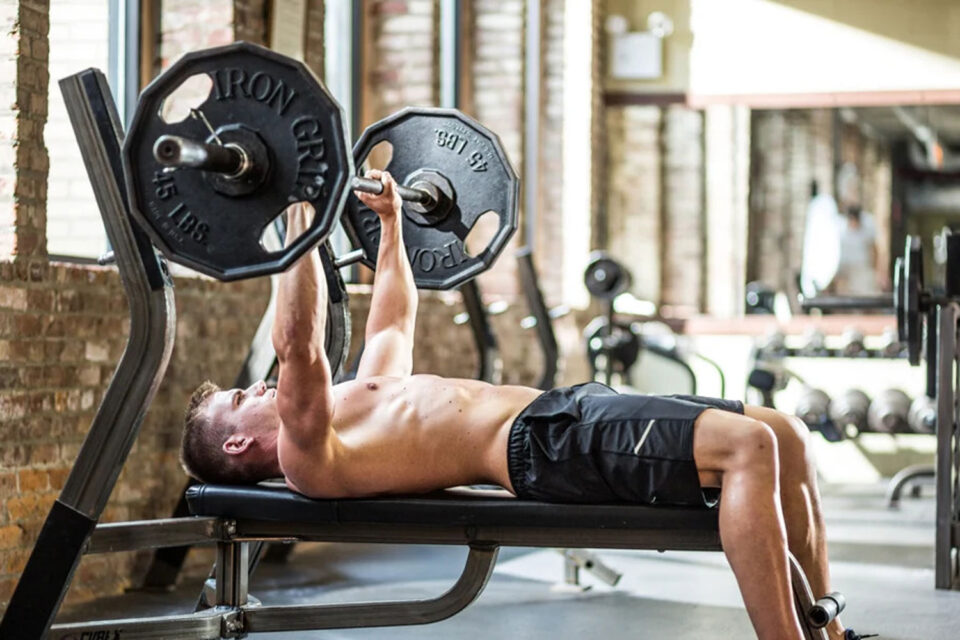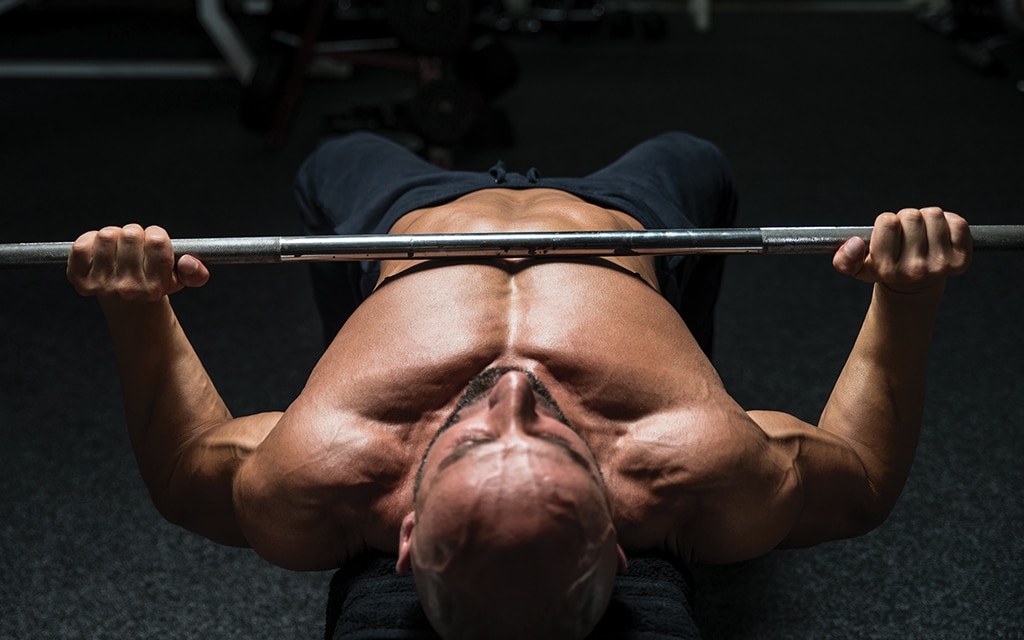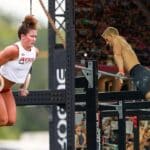The bench press and the floor press are two of the most popular exercises in weightlifting. They both have their benefits, but they are different exercises that should be used complementarily in your training routine. The bench press is a compound exercise that primarily works the pectorals, while the floor press is an accessory exercise that works the triceps, shoulders, and pectorals. The Floor Press is typically used as an accessory exercise to improve the bench press but has its benefits as a stand-alone exercise.
The apparent difference between these two movements is that the floor press is performed while lying on the floor instead of on a bench. Doing so creates a host of differences between these two pressing movements—some of which are beneficial, others not so. Let’s examine in this article.
Jump to:
- Save
- The Bench Press
- The Benefits of the Bench Press
- Save
- The Floor Press
- The Benefits of the Floor Press
- When to Use the Bench Press
- When to Use the Floor Press
- To Perform the Bench Press:
- To Perform the Floor Press:
- The Difference Between Floor Presses and Bench Presses
- Save
- Bench Press Variations
- Floor Press Variations
- Equipment Needed to Lift with the Barbell Bench Press and the Floor Press
- Which Exercise is Better for You?
- Upper Body Workout Incorporating the Bench Press and the Floor Press

The Bench Press
The bench press is a standard chest movement that many people use to target the Pectoralis Major. The traditional bench press uses a barbell lowered to the chest before pushing it back to the starting position. This exercise can be done with either a standard bench or an adjustable bench.
The Benefits of the Bench Press
The bench press allows you to lift more weight. Despite requiring a more excellent range of motion, athletes can typically raise more weight in the bench press. This occurs primarily for two reasons. In the bench press, athletes can utilize the (slight) impact of the bar hitting their chest as a recoil.
This gives momentum to the eccentric (upwards) portion of the lift—similar to the stretch-reflex one can utilize when ‘bouncing’ out of the hole in a squat. Second, the floor press is traditionally meant to be performed with the legs flat against the ground.
Based on our testing, this is the best creatine for most people. It has the perfect dosage of creatine monohydrate per serving, which has been proven to increase muscle mass.
- Promote strength and muscle gains
- Tested for purity and safety
- Creatine has no known side effects
This removes the leg drive the athlete can generate by pressing their feet into the ground, meaning that the floor press becomes a torso-dominant lift, versus the benefit of additional power generation one can achieve in the pursuit of better bench press performance.

The Floor Press
The floor press is a variation of the bench press performed while lying on the floor instead of using a flat bench. This increases shoulder stability and decreases the exercise’s range of motion, making it a good choice for those with shoulder issues. It also requires less elbow joint mobility, making it a good choice for those with elbow issues.
The main downside of the floor press is that it decreases the range of motion of the exercise, making it less effective for building chest muscle. It also requires more shoulder stability, which can be a drawback for those with shoulder issues.
The Benefits of the Floor Press
The floor press is an excellent tricep and shoulder developer. The bench Is superior for the chest. In the floor press, the arms rest on the ground at the bottom of the movement, thus removing tension and elastic energy from your muscles. That brief pause makes the lift a lot harder, but it’s compounded even further by the lack of help from a negated lower-body drive. This actually works out to your advantage in terms of building explosive strength in the triceps and shoulders. A powerful elbow extension is required to lock your arms during the initial drive. This is one reason many lifters supplement with the floor press to improve sticking points in their bench press.
The bench press targets the pectoral and back muscles more because the movement is more fluid—there’s no pause at the bottom of the lift so that you can engage your lats and chest to a more significant effect.
Furthermore, your muscles are under tension for more time because the bench press is executed with a more excellent range of motion. In addition, more muscles are recruited in the lift. This means that the body will secrete more testosterone and human growth hormone (HGH)—two hormones that are essential for building muscle.
When to Use the Bench Press
The bench press is a great exercise to build strength in the chest, shoulders, and triceps. It is a compound movement that involves multiple muscle groups, making it an excellent choice for strength gains. However, the bench press is a relatively complex movement and may not be appropriate for novice lifters.
If you are new to lifting, starting with lighter weights is best and working your way up. As you become more comfortable with the movement, you can increase your weight. Heavier weights will lead to more significant strength gains. However, be sure to focus on form first and foremost. Proper form will help prevent injury and ensure you get the most out of the exercise.
When using heavier weights, it is also essential to have a spotter. A spotter can help you get stuck during the lift and motivate you to keep pushing yourself.
Overall, the bench press is an excellent exercise for strength gains.
When to Use the Floor Press
The floor press exercise is excellent for beginner lifters because it allows them to lift heavier weights without the risk of injury. In addition, heavier weights can help beginner lifters build muscle and strength more quickly.
The floor press can also be used as an accessory movement to help lifters stuck at a plateau. By using a heavier weight than they are accustomed to, lifters can force their muscles to grow.
The floor press can help the lifter hit bench press sticking points that can help improve their bench press performance.
Accessory movements like floor presses are a great way to add variety to your workout routine and keep your body guessing. If you feel stuck in a rut, try adding the floor press to your practice.
If you have elbow pains, the floor press may help alleviate some of the discomforts. By changing the angle of your press, you can take the stress off your elbow joint.
Based on our testing, this is the best creatine for most people. It has the perfect dosage of creatine monohydrate per serving, which has been proven to increase muscle mass.
- Promote strength and muscle gains
- Tested for purity and safety
- Creatine has no known side effects
The floor press is a versatile exercise to build muscle, strength, and power.
To Perform the Bench Press:
On a flat bench:
- Grip the bar with a shoulder-width grip
- Make sure to keep your feet flat on the floor
- Squeeze the bar and move it out of the rack and over your chest
- Keep your glutes on the bench and your head in a neutral position
- Pull your shoulder blades together and dig your traps down into the bench
- Take a breath and exhale as you slowly lower the barbell down to your chest
- Tuck your elbows in close and keep your butt on the bench
- Pause at the bottom when the barbell makes contact with your chest
- Press the barbell back up until you lockout your arms
- Repeat for the desired number of repetitions
If you are looking to improve shoulder stability and overall shoulder health, the floor press is a great exercise to include in your routine. The floor press is a shoulder-friendly variation of the traditional bench press that can be changed for either dumbbell press or a barbell press.
To Perform the Floor Press:
- Start by lying on your back on the floor.
- If you are using dumbbells, hold them at shoulder-level with your palms facing down. If you are using a barbell, arch your back and grip the barbell with your hands shoulder-width apart.
- Press the weight straight up above your chest, pause for a moment, and then slowly lower the weight back down to the starting position.
- Repeat for 8-12 reps.
The floor press is an excellent exercise for beginners because it allows you to start with a lower weight and increase gradually as you get stronger. It is also a good exercise for those with shoulder pain or instability.
The floor press can also be performed with heavier weights than the bench press. This makes it a better choice for strength gains. However, the bench press may be a better choice for athletes who need to generate more power.
The Difference Between Floor Presses and Bench Presses
The bench and floor press are exercises targeting the chest muscles, but they differ in crucial ways. The regular bench press is done with a standard bench, while the floor press is done without a bench. This makes the bench press easier to perform and has a more excellent range of motion. The floor press has a decreased range of motion, making it more challenging.
The key difference between the bench press and the floor press is that the barbell is lifted off of the rack with the bar under control by the lifter throughout the entire range of motion in the bench press, while in the floor press, the barbell is lowered to touch the floor and then lifted back up. This may not seem like a big difference, but it has a significant impact on the muscles worked and the difficulty of the exercise.
The floor press places less strain on the shoulders. Most powerlifters have encountered some shoulder pain from performing the bench press. That’s because athletes tend to flare the elbows out to the side during a bench press, which places the humerus (the long bone in the arm that runs from the shoulder to the elbow) into internal rotation.
The scapula (shoulder blade) rotates up and out, forcing scapular stabilizers to work overtime while rubbing on the supraspinatus ligament. As a result, there is increased impingement in the shoulder joint. The reduced range of motion in the floor press (compared to the bench press) results in less shearing force on the shoulder joint.

Bench Press Variations
Bench press variations are a great way to switch things up in your workout routine. They can also be used to target different muscle groups. Here are a few of the most popular bench press variations:
- The flat bench press is the most common bench press variation. It targets the chest and shoulders.
- The incline bench press targets the upper chest.
- The decline bench press targets the lower chest.
- The preacher curl bench press targets the biceps muscles.
- Dumbbell Bench Presses are a great way to target the chest and shoulders simultaneously.
- The cable crossover bench press targets the chest and triceps muscles simultaneously.
Floor Press Variations
You can do many floor press variations to target different muscles and achieve different results. The heavy-weight floor press is an excellent variation for increasing muscle mass. This variation involves using a heavy weight to fatigue the muscles after a few repetitions. This will cause the muscles to grow larger and stronger over time.
Another variation of the floor press is the plate press. This variation involves holding a plate with each hand and pressing it above your head. Again, this is an excellent exercise for increasing shoulder and tricep strength.
Incorporating these variations into your workout routine can help improve muscle gains in your upper body.
Equipment Needed to Lift with the Barbell Bench Press and the Floor Press
The equipment needed to perform the barbell bench press and floor press is very similar. To complete the bench press, you will need a barbell, weight plates, and a bench or rack to hold the barbell. Likewise, you need a barbell and weight plates to perform the floor press. You can change the barbell and plates for dumbbells or kettlebells with both movements. If the gym you’re at doesn’t have dedicated bench press stations, you can use a squat rack or power rack and place the bench appropriately.
Which Exercise is Better for You?
Both bench presses and floor presses are practical exercises for developing strength and size in the chest, shoulders, and triceps. However, which one is better for you depends on your individual needs and preferences.
Bench presses are an excellent exercise for overall upper body development. They allow you to move much weight and target the chest, shoulders, and triceps. However, they can be uncomfortable for some people due to the angle of the bench.
Floor presses are a great alternative to bench presses. They allow you to move much weight and target the chest, shoulders, and triceps. Depending on your goals and objectives in the gym, floor presses may be a better choice to add to your training. For example, if you are injured or don’t have a suitable bench to perform the regular bench press, the floor press might be the better choice.
Upper Body Workout Incorporating the Bench Press and the Floor Press
Bench pressing and floor pressing are excellent upper body exercises that can help you build muscle and strength. However, if you’re trying to add both exercises into your daily workout routine, it can be tricky to fit them in. Here are a few tips to help you make it work:
- Try doing bench presses first, then follow up with floor presses. This will allow you to do more reps on the bench press since you’ll be more fatigued from the floor presses.
- Alternatively, you could do a superset of bench and floor presses. This means doing one set of bench presses, then immediately moving on to a set of floor presses without resting.
- Another option is alternating sets of bench presses and floor presses. This means doing one set of bench presses, resting for a minute or two, then doing a set of floor presses, and repeating this cycle until all sets are complete.
Whichever approach you choose, adding both bench presses and floor presses into your daily workout routine is a great way to challenge your upper body and see results.














